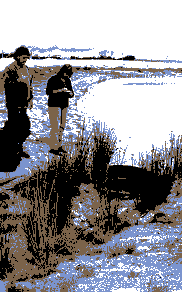|
|

|
The causes of pollution
Pollution of waterways in the south coast region occurs from a number of sources, including industry, agriculture, household and recreation. Industrial discharges still occur into Princess Royal Harbour from vegetable and fish processing companies and other industries. Across the region, urban stormwater drains provide a means for pollutants to enter the waterways from industrial and residential areas. In agricultural areas, the use of pesticides and herbicides, and the intensive farming of animals (such as in a dairy) can lead to pollution if appropriate management is not used. Some examples of pollution commonly found in the south coast region are:
The impacts of pollution Pollution is detrimental as it can impair the environmental values of a waterway. These values can be described in various ways but would include the following:
What is being done about pollution in the region? Guidelines The Department of Water produces a variety of guidelines to ensure activities do not pollute waterways. Regional staff provide input into these guidelines so that local priorities and issues are addressed. Recent guidelines include advice on the use of houseboats, recreational craft and ferries. The department also provides input to other agencies' guidelines and in recent years has provided input into recomendations for extensive piggeries, cattle feedlots and dairies produced by the Department of Environmental Protection. Regional Department of Water officers are able to draw on local knowledge and expertise when contributing to these guidelines. Advice on referrals The Department of Water provides advice on activities and landuse changes which may impact on waterways in the region. These amount to several hundred a year, and can range from large scale developments such as dredging of harbours, building of abattoirs, location of new land fill sites to small land use changes such as the expansion of a strawberry farm or piggery. The Department of Water's advice is provided to the proponent and the planning authority, and although not binding, is normally heeded. Protecting drinking water Legislation protects the region's drinking water. Two main acts are used. The Rights in Water and Irrigation Act is used to control the quantity of water extracted from proclaimed water reserves. The Country Areas Water Supply Act is used to prevent the pollution of these water reserves. The Country Areas Water Supply Act (CAWS) uses by-laws to control land use activities so pollution of water reserves does not occur, and this guidance is often incorporated into local town planning schemes. The Department of Water uses Protection Plans and a classification of Priority Areas to protect these water resources, with Priority 1 areas having the most restrictive controls and Priority 3 areas the least. Licensing of prescribed premises The main legislation controlling pollution in the state is the Environmental Protection Act, and this allows the Department of Environmental Protection to licence prescribed premises. These are premises with the potential to pollute. The Department of Water has certain delegated responsibilities to conduct inspections of licensed premises. The Department's regional officers also recommend changes and new licence conditions for various premises. The Department also undertakes auditing of industry compliance with these licences where required, and provides an annual audit of industrial discharges into Princess Royal Harbour. Monitoring and research The Department of Water undertakes monitoring and research to investigate possible pollution incidents and their sources. Recent examples of the Department of Water's work in this area includes investigations into the faecal contamination of stormwater at the Albany saleyards, oil and grease in the Yakamia Creek near Albany, heavy metal contamination in groundwater entering Wilson Inlet and Princess Royal Harbour, and the cause of a fish kill in the Pallinup River. This monitoring and research is used to advise on future development and land use activities, and can also be incorporated into licence provisions and changes to land use or management practices. Responding to pollution incidents Regional officers from the Department of Water investigate between ten and twenty alleged pollution incidents a year, in response to complaints made by the public or other agencies. These investigations are appreciated and utilised by the Department of Environmental Protection, as they are not able to respond as quickly to complaints made. Experience has also shown the public appreciates these investigations. The Department of Water has also assisted in the preparation of protocols for the investigation of pollution incidents, to ensure the pollution incidents are efficiently handled and resolved in the shortest time period. Recent protocols established include those relating to oil pollution at sea, tackling contaminated sites and the investigation of fish kills. These protocols are prepared with other agencies. Agency links The Department of Water works in partnership with other agencies in tackling pollution, with the partnership depending on the type of pollution. For pollution at sea, particularly oil, the Department of Planning and Infrastructure and the Port Authorities take the lead. This includes the harbours and navigable waters. For land based pollution the local government authority has a major role, as does Agriculture WA on rural properties. How can individuals be involved? If you have a concern regarding pollution in general or are not certain whether an industry or a premises has the right to discharge a level of pollution, then you should ring the regional office of the Department of Water. If you have specific concerns about pollution of the waterways in the south coast region, then you should contact the Department of Water's office in Albany. |